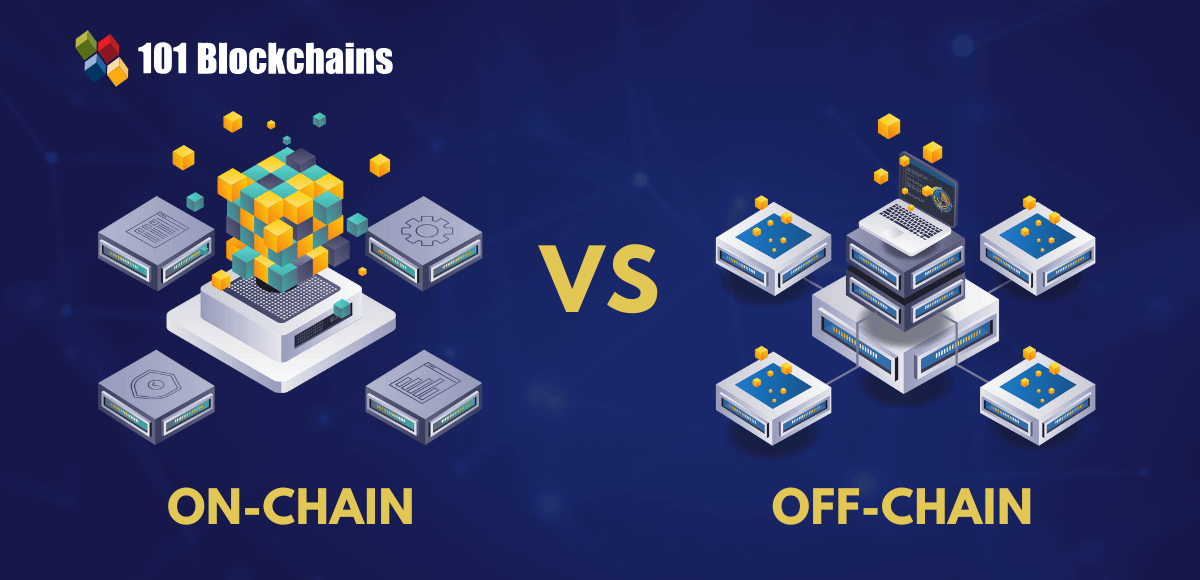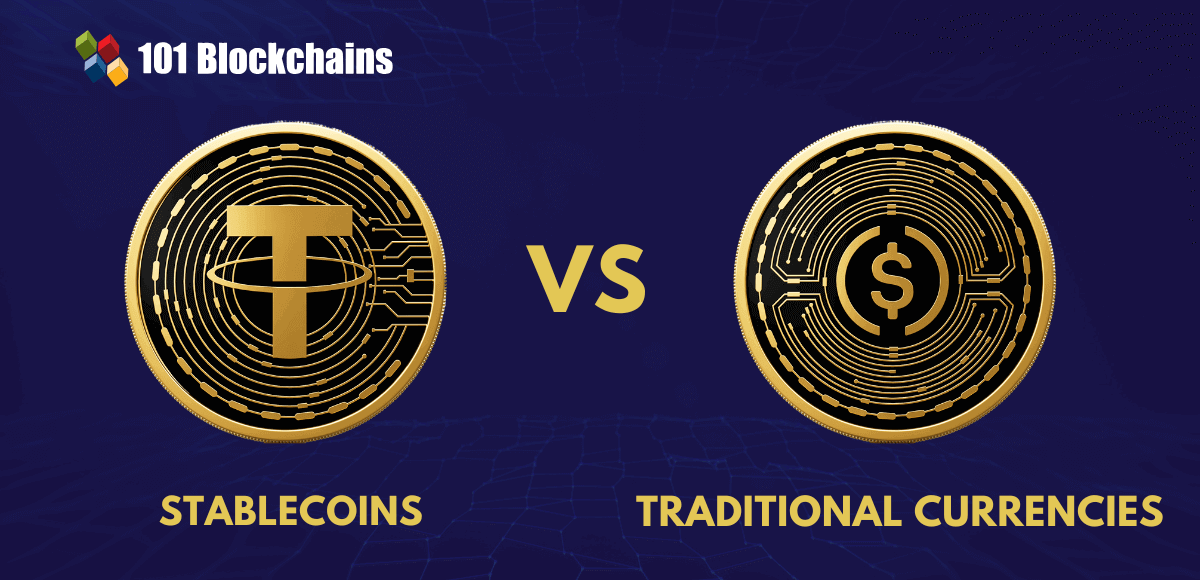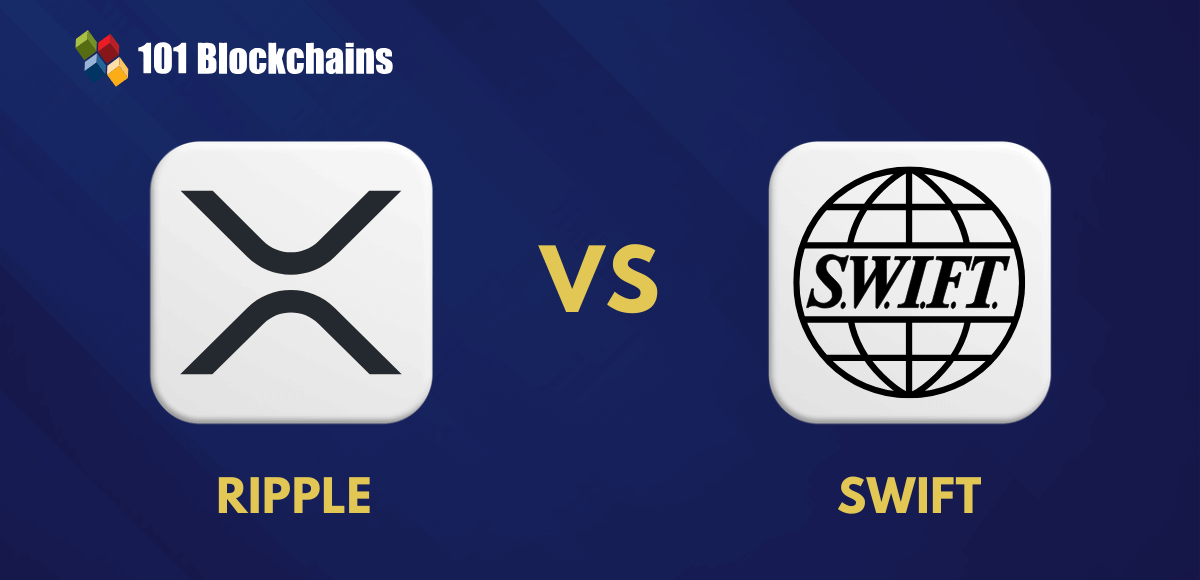Learn how blockchain truly works, master key definitions, and uncover what makes smart contracts so "smart." Dive into the fundamentals, gain valuable insights, and start your blockchain journey today!
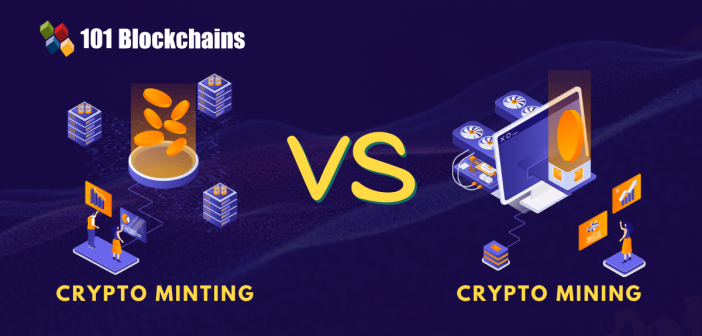
- Comparisons
Georgia Weston
- on January 06, 2023
Crypto Minting Vs Crypto Mining – Key Differences
The most profound trait visible in blockchain technology points to decentralization. All the blocks in the blockchain serve as repositories of information about assets and transactions on the blockchain. The data on a blockchain is available on a distributed public ledger, which can ensure transparency of every transaction and asset. The crypto minting vs crypto mining debate is one of the fundamental comparisons you must focus on before entering the blockchain and crypto domain.
Decentralization implies the need for verification of transactions on blockchain by multiple verifiers rather than a single authorized intermediary. The nodes in a network assume the role of verifiers and have to reach a consensus on the authenticity of transactions. Almost every blockchain network follows the template of decentralization. However, the method for verification of blocks or transactions could differ from one network to another.
The crypto minting vs mining comparison relies profoundly on the difference in consensus mechanisms. What are crypto mining and minting? Do they have any similarities between them? The following post offers a detailed overview of the differences between crypto mining and minting with comprehensive explanations for both.
Build your identity as a certified blockchain expert with 101 Blockchains’ Blockchain Certifications designed to provide enhanced career prospects.
How is Cryptocurrency Created?
The primary theme underlying the minting vs mining crypto debate revolves around the creation of cryptocurrencies. Beginners in the field of blockchain and cryptocurrencies have doubts about the methods for creating cryptocurrencies. Interestingly, newcomers can also draw parallels between the creation of cryptocurrencies and fiat currencies.
In the case of fiat currencies, mining refers to the process of mining ores of precious metals such as gold and silver. On the other hand, minting in fiat currency points at the process of creating new coins and establishing them as legal tender, alongside pushing them into circulation. However, cryptocurrency minting is not the same as minting coins in real life. Similarly, cryptocurrency mining does not have anything to do with mining of silver, gold or other precious metals. Therefore, you can determining the differences between minting and mining cryptocurrencies only with a detailed understanding of both terms.
Excited to know the use cases of crypto in NFTs, DeFi, and the metaverse, Enroll now in the Cryptocurrency Fundamentals Course
Fundamentals of Crypto Mining
The discussions on minting vs mining would emphasize the comprehensive fundamental overview of both processes. Cryptocurrency mining refers to the verification of transaction blocks on a blockchain network by specific nodes in the blockchain, known as miners. The miners participating in the verification of blocks receive rewards and incentives in the form of crypto assets for preserving the security of the blockchain network. Mining is responsible for generating cryptocurrencies while rewarding miners for keeping the network operational and secure. How do miners validate transactions on the blockchain ledger in cryptocurrency mining?
You can find reliable answers to “Is minting the same as mining?” by understanding the basic process of crypto mining. Cryptocurrency mining involves many other implications underlying the verification of transactions. Miners use massive amounts of hardware processing power alongside advanced software for solving complex algorithms to verify transactions on the blockchain. Upon successful verification and addition of a block to the blockchain network, miners could receive rewards in the form of cryptocurrencies for validation of transaction blocks.
Important Requirements in Crypto Mining
One of the essential requirements in crypto mining refers to the need for specialized hardware to ensure high performance. Specialized hardware is essential for addressing the difficulties in different processing tasks for validating and recording new transactions on blockchain networks. Therefore, crypto mining can ensure viable advantages for safeguarding security on blockchain networks. Each hardware or software associated with the crypto mining process is known as the network node.
Interestingly, the minting vs mining crypto difference would point to the competition among nodes for the correct prediction of a hexadecimal integer, the transaction hash. Miners who find the transaction hash before others can update the new transaction block on the blockchain network. Subsequently, the miners would receive rewards in the form of newly “mined” cryptocurrency.
Miners have to invest huge amounts in acquiring the high-end processing power required for mining. On top of it, the difference between minting and mining cryptocurrency would focus on how the miner’s system must ensure local storage for multiple transaction ledgers. Therefore, mining would require significantly high volumes of data, which does not leave any scope of profits for individual miners.
On the contrary, mining farms can capitalize on the opportunity with their high-end mining equipment and seamless supply of electricity. Furthermore, mining farms could also fall short of the requirements of mining power. As a result, mining farms can combine their computing power in a mining pool. Now, mining pools can ensure reward sharing in the proportion of power generated by every mining farm.
Want to get an in-depth understanding of crypto fundamentals, trading and investing strategies? Enroll now in the Crypto Fundamentals, Trading And Investing Course
Proof of Work Blockchain and Crypto Mining
The concept of mining for cryptocurrencies started off with the first popular cryptocurrency, i.e., Bitcoin. As a matter of fact, Bitcoin helped in the popularization of the Proof of Work or PoW consensus algorithm. Many blockchain networks use the Proof of Work consensus mechanism for block verification owing to the advantages of security.
You can find a reliable impression of crypto minting vs crypto mining differences with a detailed understanding of the mechanism behind crypto mining. The three essential components in the Proof of Work consensus mechanism are miners, hardware and electricity. Let us find out the role of these components in crypto mining.
-
Miners
Miners or validators are integral components of crypto mining processes. Every blockchain has specific requirements for running its nodes. Therefore, you need to check out the node prerequisites of a blockchain before assuming the role of a node or validator. For example, you must have Bitcoin node software installed on your machine for running a Bitcoin blockchain node. Subsequently, you must connect the hardware to the node software for initiating the validation process.
Want to become a bitcoin expert? Enroll Now in Getting Started with Bitcoin Technology Course
-
Hardware
Hardware, also referred to as mining rigs, is another vital component in crypto mining processes. You can become a blockchain validator only after connecting a machine’s hardware to the blockchain network. The crypto minting vs mining comparison would point to the need for special capabilities in the hardware for solving complex mathematical problems. Miners receive complex problems as a challenge with every new block. In the case of Bitcoin, the average time for the generation of new blocks is around 10 minutes. At the same time, you must notify the gradually increasing complexity of problems with the addition of new blocks. Therefore, high-end hardware is not the only saving grace for miners with the increasing complexity of problems.
-
Electricity Requirements
The overview of crypto mining components emphasizes the difficulty of crypto mining. However, it is also important to identify the minting vs mining difference in another crucial area i.e., electricity consumption. Miners must keep their hardware or mining rigs consistently operational for achieving desired profits from crypto mining. In addition, the high-end hardware also implies the consumption of energy in substantial margins. On top of it, miners must also take permission from local administrative authorities for the installation of the mining farm infrastructure.
The cost of mining hardware, setting up blockchain nodes, and electricity consumption make crypto mining an expensive venture. In addition, the competition among miners complicates crypto mining further, thereby creating challenges for earning desired rewards.
Embrace the technological leap and global adoption that awaits in the upcoming bull run of 2024-2025 with Crypto Bull Run Ready Career Path.
What is Crypto Minting?
The explanation for fundamentals of crypto mining invites curiosities about the other entry in the minting vs mining crypto comparisons. Crypto minting is a comparatively new phenomenon with respect to crypto mining. Minting refers to the creation of new crypto coins in the form of rewards for validators for confirmation of transaction blocks, data authentication and recording new transaction blocks on the blockchain. Crypto minting follows the Proof of Stake consensus algorithm and has a significant relationship with staking. Proof of Stake consensus algorithms uses staking for the coordination of transaction data verification and transaction block validation.
One of the essential requirements in Proof of Stake blockchain protocols would refer to validators. You can consider validators for crypto minting as the counterparts of miners for crypto mining. Validators are an important aspect in determining the difference between minting and mining cryptocurrency with their distinct roles and requirements. Users can become validators on Proof of Stake blockchain protocols by staking native coins on the blockchain. Subsequently, the consensus mechanism chooses validators with a completely random and automated approach. Interestingly, users staking more coins in the network are more likely to be selected as validators for verifying blockchain transactions. The primary responsibility of a validator focuses on the documentation and confirmation of each transaction on the blockchain.
Crypto minting also involves special provisions for holding validators accountable for their actions. Validators could lose their staked cryptocurrencies for violating the protocol rules. On the other hand, rewards for validators in crypto minting are derived from the transaction fees paid by users for performing transactions on the Proof of Stake blockchain.
Start learning Blockchain with World’s first Blockchain Skill Paths with quality resources tailored by industry experts Now!
Proof of Stake Blockchain and Cryptocurrency Minting
The discussions on “Is minting same as mining?” could find plausible conclusions only with a comprehensive impression of what exactly happens in crypto minting. As of now, you know that Proof of Stake blockchain networks are the ideal platforms where validators can mint cryptocurrencies directly rather than mining them. Users can join Proof of Stake blockchain networks in the role of validators through staking a specific amount of tokens in the form of collateral. The validators must lock up their staked cryptocurrency in the Proof of Stake blockchain network for a specific duration of time. Remember that the amount of tokens you must stake in a PoS blockchain network can be pre-defined.
After staking your cryptocurrencies in the blockchain, you have to wait your turn for being selected as a validator. It is important to notice that Proof of Stake blockchain protocols select validators randomly from the pool of users who have staked their cryptocurrency in the blockchain. Upon successful validation of transactions and adding them to the blockchain, validators could receive a share of the transaction fees. Therefore, validators are known to mint cryptocurrencies or generate new cryptocurrencies rather than unearthing (mining) existing cryptocurrencies from the blockchain.
Another important aspect you must consider in the crypto minting vs crypto mining comparison would refer to penalty for validators. If validators engage in malicious actions, they are likely to lose their stake in the consensus. Crypto minting does not ignore the basic tenets of decentralization as every transaction must be approved by majority of validators for generating new blocks. On top of it, you must also notice that the selection of validators is not truly random in most blockchains. How? Most of the PoS blockchain networks select validators on the basis of highest stakes in the network.
Curious to know the impact and in-depth understanding of crypto compliance in businesses? Enroll now in Crypto Compliance Fundamentals Course.
Differences between Crypto Mining and Crypto Minting
The comprehensive explanation of crypto mining and crypto minting fundamentals showcases the basic framework for comparing both methods. Both processes are crucial requirements for creating cryptocurrencies. However, the difference between minting and mining cryptocurrency showcases how they are useful for different groups of users. One of the basic points of difference between crypto mining and minting refers to the use of Proof of Work and Proof of Stake consensus, respectively. While the goals of crypto mining and minting are the same, they use different processes to achieve the goal.
Here is an outline of the differences between crypto mining and crypto minting in the form of a table.
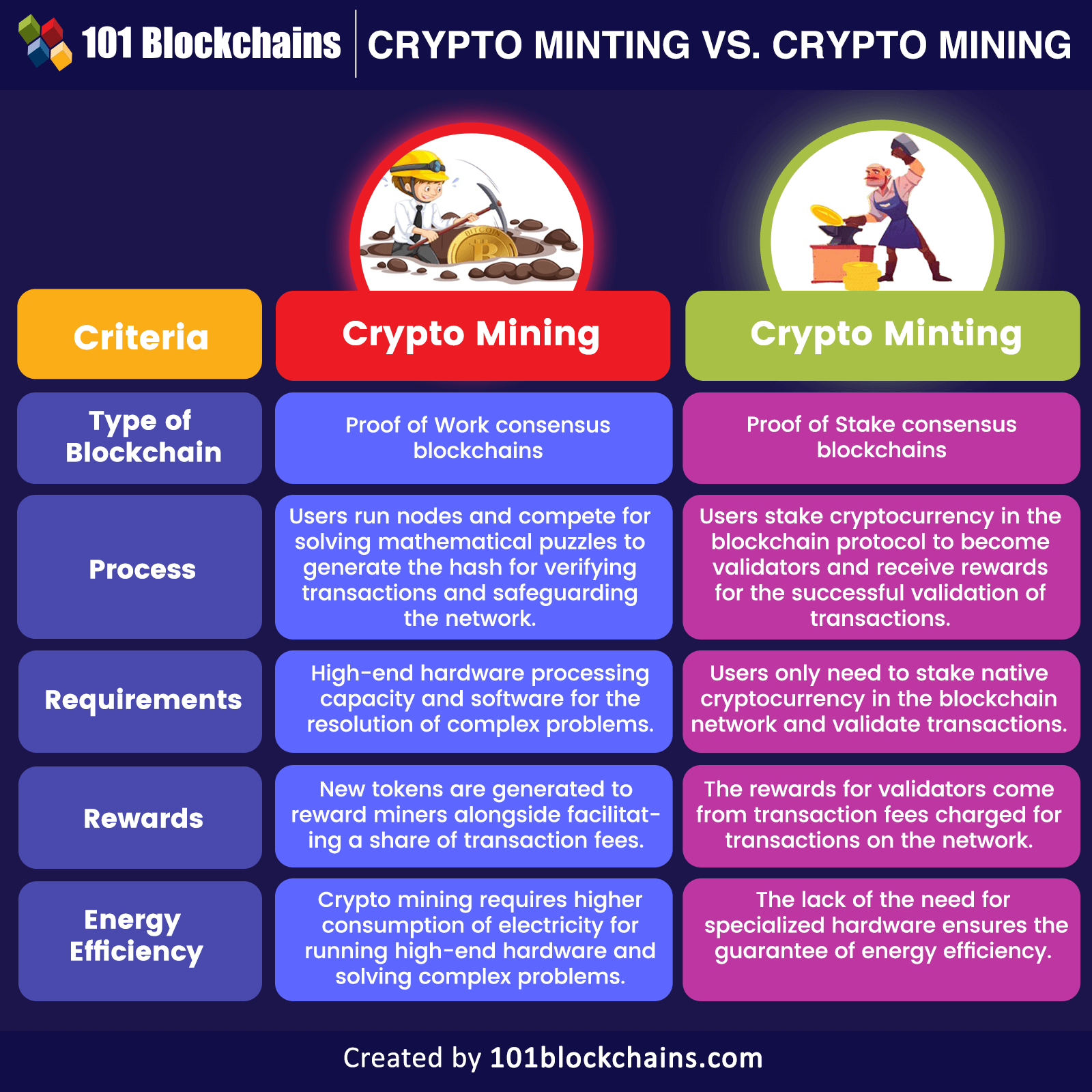
Please include attribution to 101blockchains.com with this graphic. <a href='https://101blockchains.com/blockchain-infographics/'> <img src='https://101blockchains.com/wp-content/uploads/2022/12/Crypto-Minting-Vs-Crypto-Mining-1.png' alt='Crypto Minting Vs Crypto Mining='0' /> </a>
Get familiar with the terms related to cryptocurrency with Cryptocurrency Flashcards
Final Words
The final overview regarding the minting vs mining debate in the domain of blockchain and crypto suggests that minting is the better alternative. For starters, it is energy efficient, which calls for better prospects to enable the adoption of crypto minting on a broader scale. Furthermore, crypto minting does not require the installation of high-end hardware and node software like crypto mining.
Therefore, crypto minting is more accessible than crypto mining. On the other hand, crypto minting has some setbacks in the possibility of malicious actions by validators. As a result, crypto mining turns out as a winner over crypto minting in terms of security. Learn more about blockchain technologies and identify the suitable method for creating cryptocurrencies now.
*Disclaimer: The article should not be taken as, and is not intended to provide any investment advice. Claims made in this article do not constitute investment advice and should not be taken as such. 101 Blockchains shall not be responsible for any loss sustained by any person who relies on this article. Do your own research!




